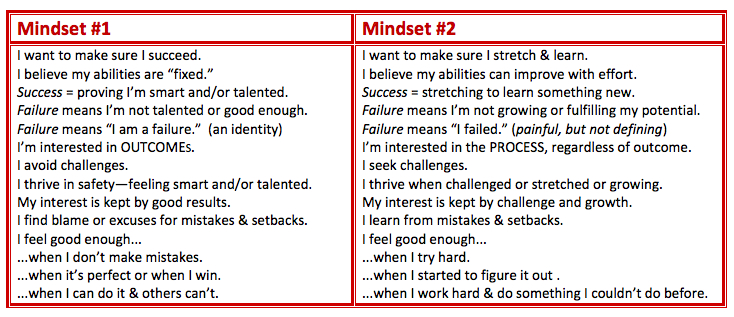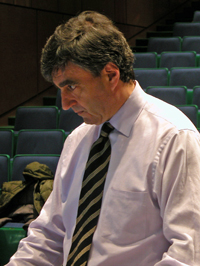What kind of learning culture do you currently have in your classroom or learning environment? What types of decisions do you make to support this culture?
Within the past four years, I have attended two professional development institutes at the Science Museum of Minnesota that have profoundly impacted the learning environment I have established in my classroom. Now, you'd think that a teacher workshop at a science museum would be all about fun experiments and getting messy, but this wasn't necessarily the case. Though there were some various labs scattered throughout the week that made us science teachers as giddy as kids on Christmas morning, the overarching theme of the institutes was how do we empower EVERY learner? All of us educators say we think all students have the potential to learn and will do everything in our power to help our students accomplish this, but how does it really play out in our classrooms? Consider these examples from my own experiences and ask yourself if they feel familiar:
- A student wasn't getting his assignments done. I tried to get him to come in before or after school to work on them by reminding him in class. That didn't work. I had him paged to my classroom in the morning when I knew he was in the building before school. That didn't work. I explained my concerns to his family and my principal. That didn't work. This student ended up failing the semester.
- I had a student in my class who repeatedly cheated on his assignments. Despite multiple warnings, and then consequences, he continued to cheat.
- A student was constantly disrupting my class by loudly calling out inappropriate comments that were making fun of other students. I told him to leave the classroom.
Though there is no way to adequately summarize two weeks' worth of workshop material and reflections, I'd like to share with you the one nugget from those two weeks that had the biggest impact on my classroom culture: The idea of Mindsets.
Carol Dweck is a psychologist from Stanford University who researches, among many things, student motivation. In the course of her research, she discovered something completely contrary to how many teachers and parents view learning. The ability to learn isn't determined by IQ, self-esteem, praise, or even confidence. Learning is directly related to one's impression of intelligence. About half of our students see intelligence as something they are born with. Dweck calls the condition of these students a "Fixed Mindset." The other half of our students understand that intelligence is a fluid entity, which can be changed over time. These students have a "Growth Mindset" according to Dweck. (Dweck, Self Theories, 1999). The diagram below summarizes the effects these mindsets can have on students (Mindset #1 is Growth, Mindset #2 is Fixed).
 |
| *From http://www.musicpeakperformance.com/wp-content/uploads/2012/05/Mindset-Comparison.jpg |
Looking back at the three examples of students that I shared with you, it is more than likely that the barrier to these students' learning was their fixed mindset. They believed they could not learn in my class, and acted in various ways to protect themselves from feeling "stupid." Some students act out in class or say they're bored to draw attention away from their perceived inadequacies. Other students are so convinced they could never learn the material that they resort to cheating. Finally, there is a group of students that just completely gives up. They'd rather not try at all than experience any perceived "failure" once again.
Now, what does all of this have to do with my classroom culture? Well, as a result of reading Dweck's Self Theories and reflecting on its implications for my teaching, here's the teaching philosophy that I developed, and still share with my students to this day:
All students can learn.
Therefore, all students can, with support and help,
deepen their understanding of science.
Students and teachers alike will establish high expectations that all students will achieve.
Although I may have thought about my classroom in this way in the past, I didn't always act in this way. So I changed the routines in my classroom to truly reflect this philosophy.
First of all, students always get 100% on all of their notebook assignments. Students have composition notebooks in which all of the class material gets entered: labs, reflections, review, journaling. I originally thought I'd give each notebook assignment a score, and then give the notebooks back for corrections. I was shocked to find that the majority of the students never made corrections! Even though students had low scores, they had internalized a fixed mindset and decided that they couldn't ever understand their mistake so it wasn't worth their while to try and correct it. So, now my students don't get scores on their assignments at all until they're perfect. A student will turn in a lab the first time, I'll write comments and suggestions on it, s/he will work on those problem areas, they'll turn it back in and I'll look it over again, there might still be some corrections they need to fix up so they get it back a second time, and so forth and so on until they have it right. Then, finally, I enter a grade for the assignment. And it's always perfect because the student continued to work on the assignment until all of their mistakes and misunderstandings were cleared up. Isn't this the whole point of learning? What are we saying about the importance of what we teach if getting 75% on an assignment is "good enough" for a student to move on? More importantly, what are we saying about that student's abilities?
I have found that students don't give up on an assignment as easily if they view it as a "process" from the beginning instead of a one-shot attempt. I am very explicit with my students as to why I do this (because believe me, they do complain when they get their notebook back for the third time and they still have corrections to do!). I make it clear that learning takes time - and it takes different amounts of time for different people. If my students understood everything in class right away, they wouldn't need to be in the class. I also embrace this "learning as a process" mentality for quizzes, tests, and projects. I don't want to take up the space going into detail about these here, but I can summarize it all by saying that students know that they will get the time and support they need to master any assignment in my classroom.
This philosophy doesn't always work out perfectly, of course. There are the one or two students out of 100 or so that simply refuse to believe they can learn at a high level. Also, all of the correcting can get overwhelming. But overall, speaking to my students on a regular basis about the ability of everyone to learn given enough time and chances, and backing up that rhetoric with policies that ensure every student has as many chances as they need to succeed - as long as they keep trying - has completely changed my classroom climate. Cheating has become less of an issue in my classes because students don't feel the pressure to perform when they're not ready. Students are focused less on "did I get it right?" and more interested in seeking resources to help them understand class content better. Students who have never felt successful in a science class suddenly realize that they can understand this stuff. I had a student who had an IEP and his special education teacher questioned if he should even be in my Biology class. I told her that he could definitely make it through. Although he struggled in the beginning, once he realized that he could continue to redo his work until it was correct - and the impact that would have on his grade - he was coming into school regularly after hours to get help on the corrections that were needed on his assignments. The look on his face when I showed him that he aced a quiz was priceless. So many students will just "settle" for doing mediocre work. I create a culture in my classroom in which the students know I expect their best, but I will give them the time and the tools to get there.
Flipping my classroom has blended seamlessly into this philosophy as one of those tools students can use to personalize their learning. Instead of students being expected to absorb all of the necessary content in one sitting, they are now able to take in the content at their own pace and as many times as they need. This further supports the idea that learning is a process that moves at a different pace for each student, and in each topic. While one concept may "click" immediately with a student, another topic might be more challenging and require more video views or more tries at his/her assignment. A who had struggled in a previous class of mine went out of her way to tell me how much she loved having videos to access in this new class with me. She reported that she has always had a hard time keeping up with lectures in class, and even when she does write things down, she can't remember what it was all about when she goes back to look at her notes. In my flipped classroom, however, she loved the fact that she was able to access the content at her own pace and as many times as she needed. When she had corrections to make on her assignments, she repeatedly went back to the videos to help research her questions. A flipped classroom supports a learner-centered culture because it gives students equal opportunity in accessing the content.
When I implemented the "all will learn" philosophy in my classroom, I was surprised by one fortunate side affect: My relationships with students became more authentic. I think I am less likely to be viewed by the students as "the judge," handing down sentences (grades) like grand pronouncements. Instead, we are collaborators, working together to find a way for them to understand the material. They know that I will respond to their needs and requests in the learning process. Students finally "fess up" when they are uncertain of a new topic because they understand that there isn't a penalty for "not knowing." I keep the lesson plans flexible so that if the students make it clear to me that the whole class needs another day of review, I find a way to make it happen. This open conversation about learning between my students and myself has nurtured a sense of trust and safety in my classroom.
For more information about mindsets:
Dweck's Faculty page at Stanford: http://bit.ly/10sbspe
TED Talk by Angela Lee Duckworth regarding "grit." References Dweck: http://bit.ly/10sbspe
From New York Magazine. Discussion of Dweck's research and its implications for praising children: http://nym.ag/10sbEF5







